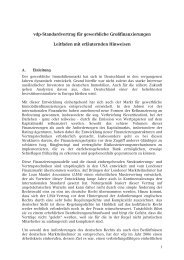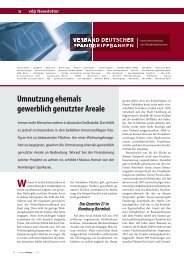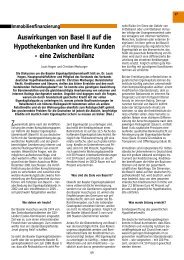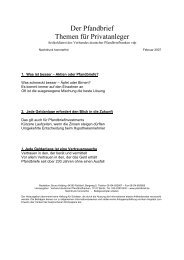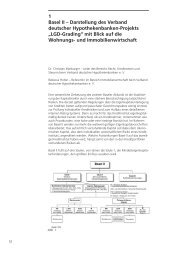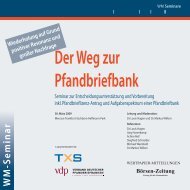The Pfandbrief 2011 | 2012
The Pfandbrief 2011 | 2012
The Pfandbrief 2011 | 2012
You also want an ePaper? Increase the reach of your titles
YUMPU automatically turns print PDFs into web optimized ePapers that Google loves.
Effects of Basel III on the <strong>Pfandbrief</strong>-based lending business<br />
30<br />
<strong>The</strong> new Basel rules recognise three categories of capital: common equity Tier 1 capital,<br />
additional Tier 1 capital and supplementary (Tier 2) capital. Each of these three categories is<br />
defined using a list of qualifying criteria (each of which must be met). Tier 3 capital has been<br />
completely eliminated by Basel III.<br />
On the one hand, the quality of regulatory capital will be enhanced by the fact that these<br />
qualifying criteria are significantly more restrictive than before, especially with respect to<br />
which hybrid equity instruments can be counted toward a bank’s regulatory capital. <strong>The</strong> initial<br />
restrictions have already been implemented by the recent amendment to the German Banking<br />
Act (KWG) effective 31 December 2010, which transposed the EU’s CRD II amending directive<br />
into law. Basel III will lead to additional limitations. Under Basel III, only hybrid instruments<br />
with no maturity date and no incentives to redeem will continue to be considered as regulatory<br />
core capital. Most of the components that can no longer be counted as core capital under<br />
Basel III will be phased out over a 10-year period beginning in 2013. However, this period<br />
will have to be reconciled with the significantly longer transition periods provided for with the<br />
implementation of CRD II. In a departure from the general qualifying criteria that are independent<br />
of legal form, the Basel Committee proposes that a joint-stock company’s common equity<br />
Tier 1 capital should include only paid-in capital and retained earnings – but there are signs<br />
that this highly disputed Basel III restriction will not be adopted into European Union law.<br />
On the other hand, deductions used to determine regulatory capital will also be redefined,<br />
primarily with the goal of harmonising them internationally. In addition, in future they will be<br />
deductible only from common equity Tier 1 capital, not half from core capital and half from<br />
supplementary capital, as allowed previously in some cases. With respect to the structure of<br />
the regulatory capital, this will lead to an increase in the significance of common equity Tier 1<br />
capital, which is viewed as particularly high quality, thanks to its distinct loss-absorbing<br />
capacity. Basel III proposes a gradual adjustment to the new deduction requirements, from<br />
the beginning of 2014 until the beginning of 2018.<br />
Common equity Tier 1 capital<br />
Specific criteria<br />
e.g., shares, retained earnings, capital<br />
contributions by dormant partners, cooperative<br />
society shares<br />
Other Tier 1 capital<br />
Specific criteria<br />
Deductions<br />
including goodwill, deferred taxes,<br />
share buybacks<br />
<br />
Tier 1 capital<br />
Supplementary (Tier 2) capital<br />
Specific criteria<br />
Tier 3 capital




